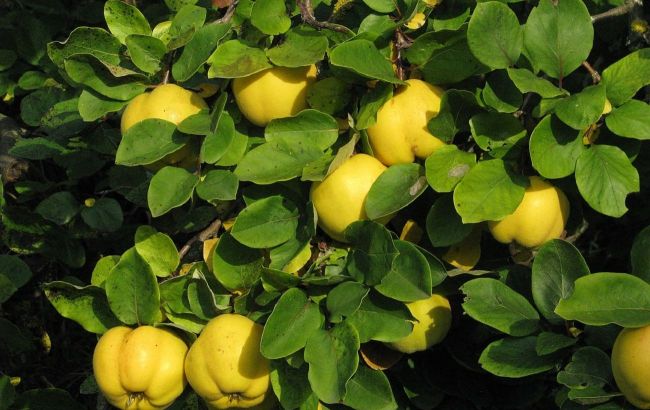Quince juice to boost your immune system and fight infections
 Photo: How quince is good for the body (wikipedia.org)
Photo: How quince is good for the body (wikipedia.org)
Quince juice, thanks to its high antioxidant content, supports the immune system and thus alleviates the symptoms of colds and flu. This healthy drink is also a source of tannins that alleviate stomach problems.
RBC-Ukraine dwells on other diseases it is worth using it for.
Healing properties of natural quince juice
Quince juice is made from the fruit of this fruit (Cydonia oblonga), also called Polish lemon, due to its sour taste and high vitamin C content. Quince blossoms in May and the fruits ripen in October. They look like apples. The fruit of the common quince is compact, pale yellow, and quickly darkens when cut. When raw, it has a tart flavor but is ideal for homemade preparations such as juices, preserves, or tinctures.
The calorie content of quince in 100 g of fresh fruit is 57 kcal, making it a low-calorie fruit.
This portion contains 15 g of carbohydrates, including 1.6 g of dietary fiber, a small amount of protein (0.4 g), and a small amount of fat (0.1 g).
Quince is a good source of vitamin C, as 100 g contains 15 mg of ascorbic acid, which supports the body's immune system and fights infections.
Quince juice is a source of valuable antioxidants, i.e. compounds that protect the body's cells from damage caused by oxygen free radicals. Excessive radicals increase the risk of lifestyle diseases, including atherosclerosis, type 2 diabetes, or hypertension.
Organic acids such as malic acid, tartaric acid, citric acid, and fumaric acid are responsible for the tart taste of quince juice, but their properties improve the digestive system and increase the absorption of calcium and iron.
The pulp contains tannins, which have an astringent effect, and flavonoids (quercetin, anthocyanins, carotenoids), which have an anti-cancer and detoxifying effect on the body. Quince juice also contains a large amount of pectin, which, due to its gelling properties, helps to remove toxins and heavy metals from the body.
What does quince juice help with?
It has a positive effect on the immune system
Quince juice is usually consumed in the fall and winter because it helps to strengthen the immune system. Due to its antibacterial properties, it is often used in people with dry coughs caused by respiratory infections.
Chlorogenic acid, contained in quince peel juice, reduces the ability of bacteria to multiply and helps to eliminate them from the body. However, the high content of tannins with an astringent effect effectively supports the treatment of diarrhea.
Boiling quince juice produces a phenolic extract that protects red blood cells and prevents their breakdown. Therefore, the drink can be used to prevent anemia.
Who can't drink quince juice?
Despite its beneficial properties, quince juice is not recommended for everyone.
Quince products sold in stores should not be consumed by people with diabetes due to the frequent addition of sugar to the product.
Excessive consumption of these products by diabetics can cause hyperglycemia, i.e. an increase in blood glucose levels. Pregnant women should also avoid drinking this drink as it can cause stomach problems. It is better to consult a doctor before starting a diet.
Use ready-made quince products (juices, mousses, syrups) following the manufacturer's recommendations. Do not exceed the recommended daily dose and do not consume the product after the expiration date.
How to make quince juice?
The simplest quince juice recipe does not require much experience or special equipment. It is undoubtedly worth making concentrated quince juice to enjoy during the fall and winter.
It will strengthen your immune system, and as an additive to tea with honey, it will warm you up perfectly. The waste products of quince juice production are seeds, which can be used in the form of an infusion that stimulates digestion and speeds up metabolism. Pour boiling water over a tablespoon of seeds, pour into a jar, stir, and wait 3 hours.
To prepare the main quince juice, you need to prepare:
- 1 kg of quince fruit (4-5 pcs.),
- 1.5 kg of sugar or 750 g of stevia,
- a 1.5-liter jar.
Wash the quince thoroughly, cut it into quarters, and remove the seeds. Do not peel the quince before cooking, because it contains the largest amount of essential compounds that give it a unique flavor. After removing the seeds, cut the quince into small cubes or grate it.
Put the quinces in a washed jar one by one, covering them with sugar. If you want the juice to be sugar-free, you can replace it with stevia. Stevia is sweeter than sucrose, so you should add less of it than in the case of sugar.
Cover the jar with cheesecloth and leave it in a dark place for 4 days, remembering to stir the jar daily. Quince covered with sugar should not be stored for more than a few days, because the juice may start to ferment (this is the first stage of making quince tincture).
If you want to preserve the juice for the whole winter, pasteurization is a must.
Sources: Nauka Przyroda Technologie and Post Fitoter.

